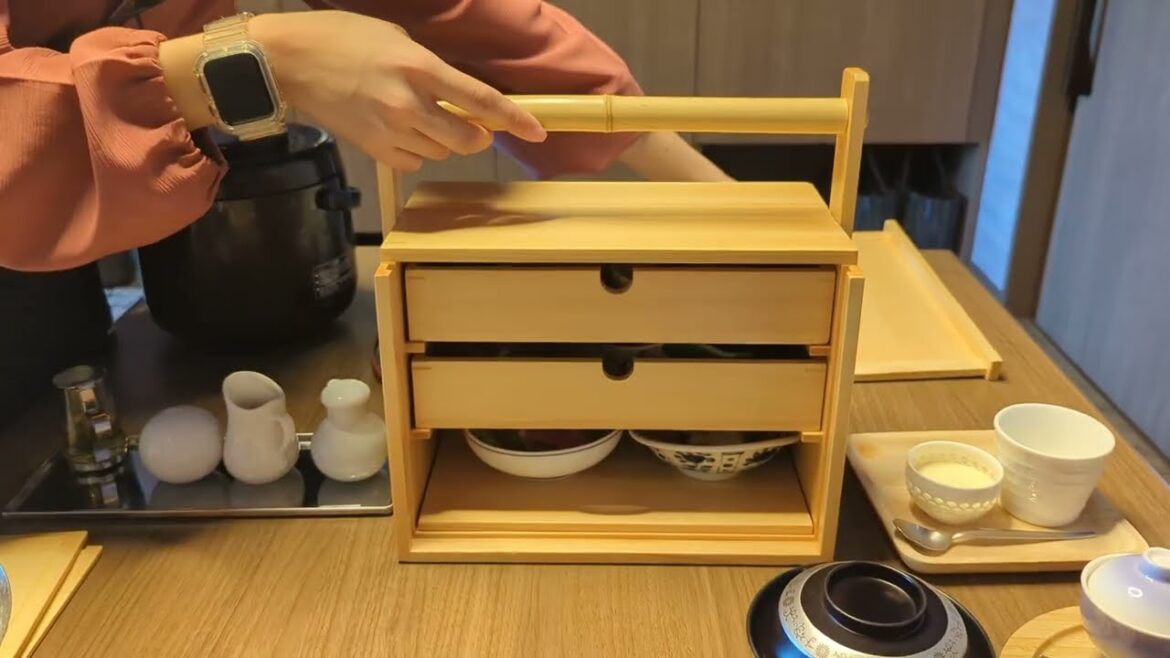A wonderful Japanese breakfast was served in my Special room “Aoi” (特別室 碧) at Kinsuikan (錦水館), a boutique luxury ryokan located just a stone’s throw away from Itsukushima-jinja Shrine (厳島神社) and the world famous Torii Gate (鳥居.) The explanation of each offering was in Japanese, but I’ve done my best to summarize everything in both languages. They are:
NIMONO (煮物 – Simmered Dish):
* Oden Jitate Buri Daikon (おでん仕立て 鰤大根 – Simmered Japanese Amberjack and Daikon Radish in a seasoned broth)
YAKIMONO (焼物 – Grilled Dish):
* Salmon no Kasuzuke (サーモンの粕漬け – Salmon pickled in the lees (residual yeast and other precipitates) of sake and then grilled)
– Dashimaki Tamago (出汁巻き玉子 – Rolled pan fried eggs that have had dashi added to the egg mix)
OKAMOCHI ICHI NO DAN (岡持ち一の段 – Okamochi top shelf. Okamochi was a wooden box/bucket that was used to carry food outside):
* Hijiki (豆鹿尾菜煮 – Boiled Hijiki Seaweed. Hijiki is a brown sea vegetable growing wild on rocky coastlines of East Asia)
* Tororo Imo (Nori Tsukudani) (とろろ芋(海苔佃煮 – Grated Nagaimo Mountain Yam with Nori Tsukudani. Nori Tsukudani is a made by simmering and pickling Nori sheets in soy sauce and mirin, and made into a paste)
* Komatsuna Itame Goma Bitashi (小松菜炒め胡麻浸し – Boiled Japanese Mustard Spinach seasoned with Soy Sauce)
* Renkon Kimpira (蓮根金平 – Lotus Root stir-fried with sugar and soy sauce)
* Karashi Mentaiko (辛子明太子 – Spicy Cod Roe)
OKAMOCHI NI NO DAN (岡持ち二の段 – Okamochi second shelf):
* Miyajima San Kaki no Oil-zuke (宮島産牡蠣のオイル漬け – Miyajima Oysters marinated with Oil Soak)
* Anago no Sansho-ni, Chirimen Sansho-ni (穴子の山椒煮, ちりめん山椒煮 – Conger Eel and Dried Young Sardines simmered with Sansho Japanese Pepper)
* Hiroshima Gyu no Salad Maki (広島牛のサラダ巻き – Hiroshima Beef wrapped over Potato Salad)
OKAMOCHI SAN NO DAN (岡持ち三の段 – Okamochi third shelf):
* Ika, Shima-Aji & Tai Sashimi (烏賊, 縞鰺 & 鯛刺身 – Squid, Striped Jack & Japanese Red Sea Bream sashimi)
* Yuuki Yasai Salad
– Tomato (トマト)
– Kyuri (胡瓜 – Cucumber)
– Koshin Daikon (紅芯大根 – Watermelon Radish)
– Iriko Miso (いりこ味噌 – Miso Red Soybean Paste mixed with dried, roasted and then powdered Sardines)
KONRO (焜炉 – Small Japanese cooking stove):
* Yudofu Tonyu Jitate (湯豆腐豆乳仕立て – Boiled Tofu with Soy Milk)
– Nameko (大滑子 – Nameko Mushrooms)
– Shironegi (白葱 – White Japanese Scallions)
– Negi (葱 – Green Onions)
– Oroshi Shoga (卸し生姜 – Grated Ginger)
– Katsuobushi (鰹節 – Dried Bonito flakes)
– Kaki Shoyu Dashi (牡蠣醬油出汁 – Oyster & Soy Sauce broth)
MISOSHIRU (味噌汁 – Miso Soup):
* Miyajima San Asari, Negi (宮島産浅利, 葱 – Miso Soup with Japanese Littleneck Clams from Miyajima, Green Onions)
KOUNOMONO (香の物 – Pickled Vegetables):
* Hiroshima Na (広島菜 – Hiroshima-grown Chinese Cabbage)
* Ninjin (人参 – Carrots)
* Nanko Ume (南高梅 – Nanko Ume Plums)
* Kyuri (胡瓜 – Cucumber)
* Daikon Asa-zuke (大根浅漬け – Thinly-sliced Daikon Radish pickled with salted kelp)
GOHAN (御飯 – Rice):
* Hiroshima San Chikutan Mai (広島産竹炭米 – Chikutan-brand Rice from Hiroshima)
KUDAMONO (果物 – Fruit Dessert):
* Cut Fruit Yogurt (カットフルーツヨーグルト – Yogurt with cut fruits)
* Jikasei Pudding (自家製プリン – Homemade Pudding)

